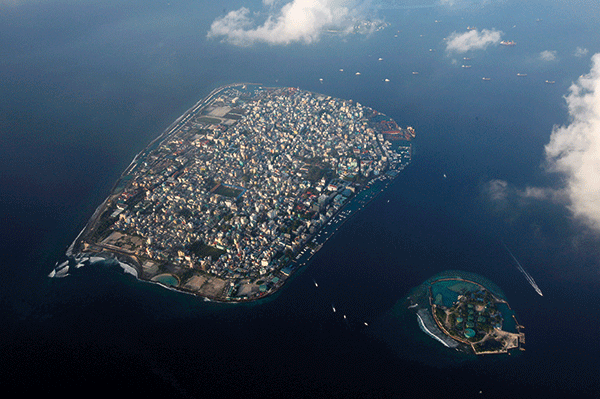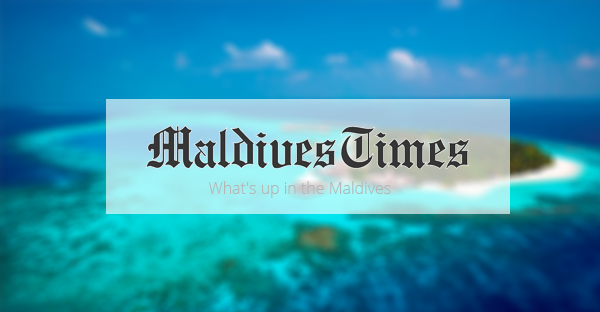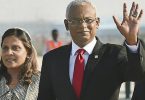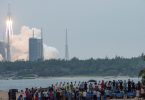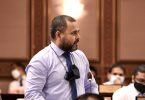To witness the yawning global disconnect in climate change finance – between those who have the money and those who need it – simply hop on a plane and head for Hulhumalé. Twenty years ago this was little more than a sandy reef, with an airport runway at one end used as a jumping-off point for sun-seekers visiting one of the 1,100 islands that make up the Republic of the Maldives.
That reef is long gone. In its place stands a reclaimed island, five miles long and two wide, owned in its entirety by the state-owned Housing Development Corporation (HDC). When complete in the 2020s, the island will be home to 240,000 people, or two-thirds of the population, boasting malls and marinas, hospitals and schools, high-end villas and a financial district.
It is the Maldives’ largest infrastructure scheme, costing hundreds of millions, if not billions, of dollars and an extraordinary case study in literal, physical nation building.
But to the careful observer, two points stand out. First, that its overseers make no mention of sustainability – odd, given that this extremely low-lying country is expected, under worst-case predictions, to all but disappear beneath a rising ocean this century.
And second, that a project that is reshaping the world’s most climate-vulnerable nation is being funded, not by the World Bank or the Asian Development Bank (or by the multiplicity of global climate funds) but by cheap capital sloshing in from Chinese development banks.
The overarching impression here is of a country that seems to have fallen off the sustainability map altogether, run by a government weary of doffing its cap to agencies and climate funds that hand out tiny morsels of cash, drawn from vast capital reserves. Far easier, it seems, for a nation desperate for growth and better infrastructure, to turn to Beijing for cheap money.
It is a strange state of affairs, summed up best by a local civil servant, who bemoans the government’s inability to plan ahead: “It seems to me that it cannot decide whether to focus on economic development or on sustainability. And it doesn’t realize that it can do both at the same time.”
Poster boy
It is extraordinary just how fast and how much the climate debate has changed in the Maldives. Back in 2009, there was a different president in charge, Mohamed Nasheed. Quick-witted and charismatic, Nasheed transformed the Maldives into a poster boy for climate change. He founded the Climate Vulnerable Forum, later the Vulnerable Twenty (V20) group of nations, which gave climate-risk sovereigns ranging from inland deserts (Afghanistan) to low-lying deltas (Bangladesh) to Pacific island states (Vanuatu) a voice and a face: the next meeting of V20 finance ministers is in Washington in October.
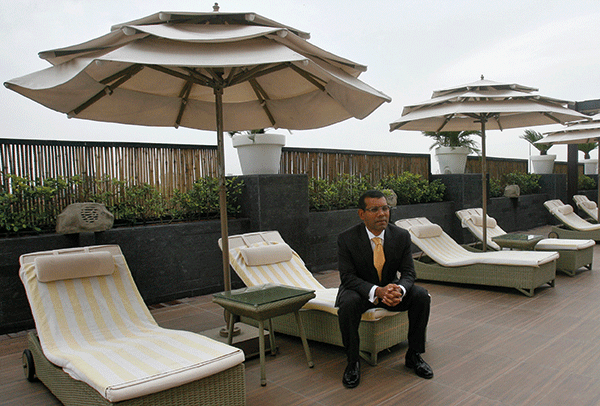 |
| Mohamed Nasheed, former president and climate change pioneer |
Nasheed held a cabinet meeting underwater to highlight the perils of a rising ocean – securing splashy headlines worldwide. In the run-up to the UN climate conference in Copenhagen in 2009, when asked what would happen if the talks failed, he replied: “We are going to die.”
Nor was this mere hyperbole designed to attract global attention and climate funding. The Maldives covers an area of the Indian Ocean roughly the size of Syria, but most of the land is barely a metre above sea level. Its chief economic strength – as an exotic destination for wealthy tourists seeking exclusivity and white-sand beaches – is also its main weakness.
The intervening years have not been good, either to the former president, or, at least in the Maldives, to the climate movement. Nasheed resigned in 2012 after weeks of demonstrations and was later jailed for 13 years on terror charges. Fêted by politicians in Washington, London and Berlin and represented by a crack legal team led by Amal Clooney, who dismiss the allegations against him as phony, he now lives in exile in London.
The current president, Abdulla Yameen, rarely mentions climate change, preferring to focus squarely on growth, jobs and infrastructure. The same is true of his cabinet. Mohamed Saeed, minister of economic development, does not downplay the threat posed by rising oceans, or wilder and more unpredictable weather.
“Climate change is real and global warming is real – no one here disagrees with that,” he tells Euromoney in his offices in the capital Malé, a tiny island packed with 140,000 people.
But his main priority, and that of his president, is growth over sustainability.
“When Yameen became president [in 2013], the country was desperate for political stability, for more jobs, for better infrastructure,” he says. “And look how far we have come. We pledged to double per-capita income to $12,000 and to create 200,000 new jobs.”
He points to a long list of projects rolled out under Yameen, from land reclamation and construction on Hulhumalé, to a new airport runway and seaplane terminal. “Crunch the numbers and you’re talking about billions of dollars of new capital flowing through the country,” he says.
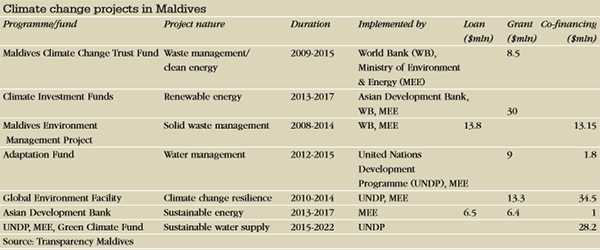 |
It is a fair argument and an honest one. It is easy to sit in an office in the developed world and underestimate the importance of jobs and growth and rising incomes for those without them. And to be fair, the economy has performed well under Yameen. The IMF tips economic output growth to exceed 4.5% in both 2017 and 2018, driven by low inflation and infrastructure spending.
But it is hard to corroborate all of the minister’s claims. Per capita income in purchasing power terms was $11,970 at the end of 2016, up 16.1% in the three years since Yameen came to power. That compares equably to income growth over the previous three years (15.8%) and the three before that (16.6%). The unemployment rate has averaged around 3% with Yameen in charge, but was half that level under Nasheed. Political stability is as elusive as ever. This year has witnessed lawmakers barred from parliament, a power struggle between the president and his nephew, and the reintroduction of the death penalty.
Lack of ambition
That the economy minister is focused on growth is unsurprising. But the sense that the climate debate has lost relevance and momentum in the Maldives is borne out by a visit to the ministry of environment and energy (MEE), the department charged with sucking in global climate-related capital and putting it to work.
The ministry, located in the three-storey Green Building on Hanhuvaree Hing’un road, should be a hive of activity, working frantically to keep an entire country’s head above water and deliver on former president Nasheed’s aim of building the world’s first carbon-neutral economy by 2019.
In theory, this branch of government gets to decide what climate-related projects should be funded and which should not. It has the last word on whether to, say, combat soil erosion by shoring up coastlines, or to promise clean drinking water to the 400,000-strong population, reducing the use of plastic bottles. Yet there is little sign of ambition here. Far from being infused with energy, the building, albeit on a hot summer’s morning, is filled with an enervating sense of ennui.
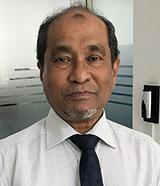 |
| Abdullahi Majeed |
After a long wait in the sweltering lobby, the minister appears and we retire to an even more oppressively hot meeting room. Abdullahi Majeed settles into a chair looking utterly spent. He wipes his brow with the back of his hand and apologizes for the weather.
“The last rains fell in May,” he says – nearly two months ago. “The wet season should last until August, but it’s become erratic, so you get short bursts of intense rainfall followed by long dry spells. The climate is changing so fast, but it’s not an easy task for us to get funding.”
That seems strange: even if its poster-boy image has faded, surely development banks and climate funds are queuing up to lavish Malé with ‘green’ capital?
Majeed shakes his head and sighs. “It’s not that simple,” he says, pointing to a benefit many in the developed world take for granted: the availability of clean water.
“For most of our people, the lack of drinking water has become a permanent issue,” he says. Not long ago, the country’s atolls would catch and store rain in the summer, eking out their reserves through the dry winter months. “But the rain no longer falls reliably, and rising sea levels means saline water intruding into the water table,” he says. “That’s why we’re now forced to ship water from Malé to more than 100 outlying islands.”
In 2015, the ministry approached the Korea-based Green Climate Fund (GCF), part of the United Nations’ Framework Convention on Climate Change, for aid and assistance on the matter.
The GCF replied, quickly and decisively. In November of that year, it committed $23.6 million to bring clean water to 49 Maldivian islands that rely on emergency deliveries from the capital for three months of the year. Another $3.6 million was pledged by the MEE, with the United Nations Development Programme (UNDP), accredited with overseeing the project, stumping up the final $1 million.
So far, so good. But progress on getting the funding from Korea to the Maldives has been horribly slow. The GCF took 20 months to disburse the first tranche of $3 million, most of which will be spent on hiring specialists to install water management, rainwater harvesting and groundwater recharge systems on four ‘hub’ islands. Confusion also reigns over which islands will be selected. The GCF in a written email said the 49 islands had been “targeted and will benefit from the project funds”, but refused to identify them by name. The UNDP identified them as highly populated islands that habitually request emergency supplies.
In June, UNDP administrator Achim Steiner said he was “delighted” with an “exciting project” that aims to bring water self-sufficiency to one in three Maldivians within five years. Steiner added: “This new, integrated approach to climate-induced water scarcity will build a more sustainable, climate-resilient future of the people of the Maldives.”
But to Majeed, Steiner’s rhetoric seemed a touch overblown: such a long walk, he sighed, for a short drink of water. The environment minister recognizes the limitations facing the best-resourced climate funds, many of which are controlled by multilaterals and development agencies like the ADB and UNDP. These vast bureaucracies are natural box-tickers, their cogs grinding slowly before a decision on whether or not to fund a project is finally spat out.
“It’s a competitive world and we are a very tiny country, and there are many much bigger nations than us, with bigger populations, who are competing just as hard to get that money,” says Majeed. He struggles to contain his frustration at the amount of paperwork required to secure a relatively small sliver of cash from these funds.
“Securing funds is a painful process. There is so much tedious form filling before you get anywhere. We have a very capable staff, but even for them, the documents [agencies send us] are often very difficult to understand.”
To be fair, the development community knows that red tape can be a hindrance, hitting smaller and under-resourced nations the hardest.
“There is a recognition of the need to simplify procedures and reduce the burden on recipient countries,” says Carl Mercer, a policy specialist at the UNDP in New York. “As for the GCF project in Maldives, there was a change in the proposal template during the early days of GCF operationalization that may have caused delays. The changes that occurred were expected as a new fund was trying to get established.”
Majeed also points to his struggle to secure funding through the Geneva-based World Meteorological Organization (WMO), a UN-affiliated agency with 191 sovereign members. This is a huge institution, vital to our grasp of shifting weather, water and climate cycles – and to governments keen to prove to funds and agencies that their problems are more acute than their neighbours.
He laments his long battle to winkle money out of the agency, blaming a lack of international experience and internal manpower.
“We have three staff coordinating with the WMO and no one on the ground in Geneva,” he says. “We receive emails from them asking us to complete a bunch of proposals and procedures, so we do all of that, and then we don’t hear from them for months. If there was less paperwork involved and if the WMO was faster at processing it, we would have got five or 10 projects funded by now.”
Then there is the cut of any climate-related project – up to 10% of the total – that winds up in the hands of the chosen accredited agency. This is simultaneously logical (in that someone with unimpeachable credentials needs to oversee the use of taxpayers’ money) yet at times nonsensical (the Maldivian water project is bookended by two UN agencies, one of which takes a cut from the other).
“We’ve been fighting this procedure for a long time,” Majeed grumbles. “We aren’t happy about it – it took us a while to realize it was going on at all. When I think that this is money that should have come to us directly, but it ended up in the hands of someone who just stamped a bunch of papers; that makes me angry.”
The UNDP’s Mercer insists that at no time does the development agency “take away from what the country receives to address its priorities. The 10% [cut] is a so-called agency fee set by climate funds themselves.”
But Majeed’s frustration is keenly felt by many smaller states unused to dealing with complex global agencies. At least in Malé, there is a sense that the international community is fiddling while the Earth burns – or sinks beneath the waves.
“There is lethargy in these places,” sighs economic development minister Saeed. “There’s too much bureaucracy, and it can at times be much too hard to secure financing.”
Fear
Stay in Malé long enough and you hear stories that make you fear for the entire process. Government officials in the Maldivian capital grumble about the Washington institution that spent millions of dollars analyzing coastal erosion, only to pull funding from a follow-up project, saying it exceeded risk controls. Or the global agency that paid for experts to stay in five-star hotels while they taught locals to use water-monitoring devices that no one could afford.
Others tell of the European Union-led coalition that in 2012 finalized an $8.5 million aid package tied to local wetland conservation and coral reef management. “It was useful,” notes Ali Shareef, director of climatology at the MEE. But, he adds, it took “more than four years between applying for the package and securing its disbursal.”
Asked how much funding the Maldives needs to combat climate change, he says: “As much as you can give”, before adding: “We need billions of dollars, not millions. If I had to put a figure on it, we need $4 billion right now, and that’s just for immediately needed adaptation projects like water security and tackling coastal erosion.”
In truth, there is plenty of blame to go around. The GCF, officially formed in 2010, has only been disbursing capital for a little over two years. And the capital it has made available has been small potatoes for a climate fund that is supposedly global in nature and scale, with an ambitious goal of raising fresh funding of $100 billion a year by 2020. (As of May 2017, it had raised just $10.3 billion, most of which it set aside as start-up costs.)
An executive at the GCF voices to Euromoney his own frustration at working within such a young yet hidebound organization.
“We want our funding to be used, but we need it to be used in the right way, and we don’t want to find later on that is has been used nefariously,” he says. But he admits: “There is a lot of sensitivity inside [the GCF] that we haven’t disbursed much money.”
One also gets a sense of national frustration at the Maldives’ inability to play the system: to be better at ticking the right boxes, getting projects primed for funding and proving that it is more than just a sponge for climate aid. A Malé-based banker points the finger at the environment and energy ministry’s piffling budget: “That should be a big ministry with serious clout, but they’re undermanned and underfunded.”
And he points to the lack of thinking within the cramped alleyways of the capital.
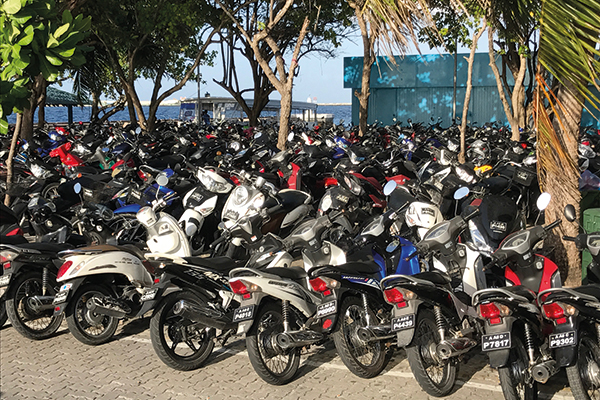 |
“This should be a carbon-neutral island,” he says. “It wouldn’t be hard. Get rid of the mopeds” – there are supposedly 1.7 two-wheelers for every citizen – “and introduce San Francisco-style trams that run on gas. Put solar panels on every roof and turbines out at sea – after all, this place is a wind tunnel half the year and a cloudless oven the rest of the time. Everything should be run on clean energy – instead, everyone has a diesel generator and everyone chokes.”
He then presents a loaded question before answering it himself. “Is this government really that interested in the environment? I don’t think so.”
It is not an unreasonable point to make. The current administration rarely mentions climate change or makes overtures to climate funds – and if they are worried about the sound of water lapping around their ankles, they aren’t letting on.
Perhaps it is in part because they do not need to. In recent years, a government desperate for new sources of capital to boost infrastructure has been more than happy to turn for funding to a new and cash-rich creditor, China.
In 2014, shortly after Xi Jinping visited Malé (the first state visit by a Chinese president in 42 years), Export-Import Bank of China (Chexim) disbursed a $373.8 million loan to build a new runway at Velana International Airport. The project kicked off in June 2017, involving the construction of a new passenger terminal, a seaplane terminal, a fuel farm, a 120,000-tonne cargo facility and a new 3.4 kilometre-long landing strip, capable of accommodating the world’s largest passenger planes. All of this is set for completion by late 2018.
Beijing Urban Construction Group, the state parent of Hong Kong-listed Beijing Urban Construction Design & Development, was tapped as contractor. Government coffers and the tourism sector are likely to be the big winners here. Economy minister Saeed said the ambition is to attract 7 million tourists a year, up from 1.2 million in 2016 and an expected 1.5 million in 2017.
China’s Chexim has also issued another loan facility of $66 million to build a four-lane road bridge connecting Hulhumalé and the expanded airport to the island-capital of Malé. That bridge is already taking shape. When the sun goes down, a giant neon sign, five metres tall and a hundred wide, buzzes to life, bearing the legend: ‘China Maldives Friendship Forever’. It is hokey, but mainland tourists are flocking to the island, flying in direct from Beijing, Shanghai and Guangzhou. Chinese visitors made up 25% of arrivals in 2016, against 6% in 2008, according to the ministry of tourism.
And an even more eye-catching transaction rocked the market in June, when BoCom International, the Hong Kong securities trading arm of Shanghai-based Bank of Communications, was picked as sole underwriter on the Republic of the Maldives’ inaugural sovereign bond. Shocked debt bankers watched as a brokerage ranked 16th on the 2017 league table of G3 underwriters in Asia, priced a $200 million five-year print in US dollars that was two times subscribed, largely by Asia-based investors.
It was a double victory for Beijing, marking the first sovereign sole mandate in US dollars for a Chinese investment bank, and underscoring how quickly it has been able to draw the Maldives, a country once tied diplomatically to India and the West, into its orbit.
But this latent addiction to Chinese development capital and institutional aid creates its own problems. Well-connected officials in Malé admit that the government has become “something of a pariah state” in the West, due to its willingness to cosy up to Beijing and the way it handled the exile and jailing-in-absentia of Nasheed, a friend of political parties in the US, UK and Germany.
Bigger problem
Perhaps a bigger problem, at least for those who care about the preservation of the country’s fragile ecosystems, is the government’s China-like obsession with massive growth-boosting projects, many of which include barely any environmental controls.
The new runway and the Friendship Bridge both remain hotly contested. Nasheed considered building them while in office, before scrapping his plans on environmental grounds. “Many believe it will change tidal patterns and wreck ecosystems,” says one ministerial aide. “But they’ve gone ahead anyway.”
Mariyam Shiuna, executive director at Transparency Maldives, the local arm of anti-corruption outfit Transparency International, notes that both Nasheed and even his predecessor Maumoon Gayoom, who ruled the country for 30 years until 2008, successfully “played the environmental card”, consulting with “key stakeholders in climate finance” when rolling out any big new project.
That compact no longer holds, she says, pointing to current projects on Hulhumalé: “There was no consultation with local communities, or with civil societies. When it comes to any discussion about environmental projects, the ministries close the door and exclude you from the consultative process.”
 |
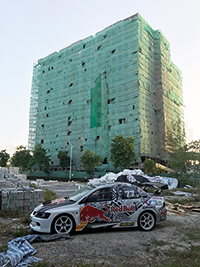 |
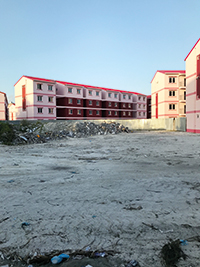 |
| Hulhumalé as it is now: (left to right) a man runs outside what will be the big international hospital; a Red Bull car in front of a half-finished scaffold-wrapped building; and half-finished public housing projects |
||
Then there is the land reclamation on Hulhumalé, a scheme that matters deeply to a country where land is in such short supply. If all goes to plan, Hulhumalé will in time become home to 240,000 people, up from 40,000 in 2016.
Viewed from any angle, this is an extraordinarily ambitious project. In less than two decades, a clam-shaped atoll as long as Manhattan is wide has been transformed into a startling vision of the future.
In July HDC, the state firm overseeing the project, kicked off a three-day networking event in Malé’s main conference hall. Bankers chatted to passers-by at stalls on the ground floor, but the real event was taking place upstairs in the main auditorium, in the centre of which stood a stunning scale model of Hulhumalé as it will be – or so the corporation hopes – by the mid-2020s. Behind it, a huge TV screened an endless loop of an idealized three-dimensional video of the island’s future.
It was pretty impressive. The video zooms in on expensive yachts moored in idyllic harbours, and on apartments shaped like sailboats. Consumers spill out of malls, to head home on a monorail that glides elegantly between glass-fronted offices. (Although there was little mention of cheaper apartments being built on a new reclaimed stretch of land to house locals and workers). It resembled a cross between a Caribbean island, Singapore’s Marina Bay and a Chinese economic zone.
The reality, as is so often the case, is rather different. Disembarking at the main ferry terminal on a warm summer’s evening on Hulhumalé is an eerie experience. The first section of reclaimed land you see, still officially named ‘Zone A’, is all but devoid of cars, people or buildings. Weeds peek through the asphalt and a cement plant, empty and padlocked, looms to one side.
A short walk away lies the ambitiously named Central Park, pockmarked with stunted trees and the occasional picnicking family. Then the buildings start. Most are cheap-looking and occupied, with clothes fluttering on drying racks. Closer to the centre of the new island, larger structures emerge: a new international hospital, the foundation pilings still being set. Then a vast plot of land slated – judging by the HDC’s literature – for office buildings, a knowledge park, a hotel, or a community centre – or perhaps all four. As darkness descends, trucks filled with Chinese labourers roar out of one of the construction sites and head toward the terminal.
Yet there is no sign of sustainability on the ground – nor any mention of it in HDC’s fancy literature. The project’s official promotional leaflet, titled ‘Hulhumalé: The City of Hope’, briefly refers to the importance of intelligent planning and the Maldives position as the “world’s lowest lying nation”. But that is it. There is no mention of the fact that, if ocean levels rise, the whole of this new island, which has also been built just a metre or two above sea level, will all but disappear.
Nor are there any visible signs of long-term, sustainable thinking. No solar panels are visible on the roofs of offices or apartments in the video, nor are they any more evident out on the island itself. Just three non-working LED streetlights were spotted on a dusty avenue leading south from the ferry terminal, lost among a long row of old-fashioned orange sodium lamps.
Back in the capital, a banker at an international lender outlines one of the project’s most glaring defects. His financial institution and many others were approached by the government to help fund social housing on Hulhumalé.
“We wanted to help,” he says, “but wherever we turned, we ran into obstacles. We’d ask: ‘Where is the cement coming from to build the houses? What about the timber, the glass, the aggregate?’ Always there was no answer. We wanted to meet suppliers and see their credentials, but no one knew who they were. Hulhumalé is not a professional operation.”
A short history of China in the Maldives
* September 2014 Xi Jinping visits the Maldives – the first visit to the country by a sitting Chinese head of state since 1972 – meets Maldives president Abdulla Yameen, and secures support for Beijing’s Belt and Road Initiative (BRI).
* October 2014 Export-Import Bank of China (Chexim) disburses $373.8 million loan to build a new 3.4 kilometre runway, seaplane terminal and cargo facility at Velana International Airport. Beijing Urban Construction Group (BUCG), which replaced Indian infrastructure firm GMR on the ticket, is set to complete the project by late 2018.
* October 2014 Chexim issues $66 million loan to build a bridge connecting the airport with the island capital of Malé. BUCG is hired to build the four-lane ‘China-Maldives Friendship Bridge’.
* 2016 300,000 Chinese tourists account for 25% of all arrivals in the Maldives, up from 42,000 – 6% – of arrivals, in 2008.
* April 2016 Maldives foreign minister Ahmed Naseem says China has bid to build a port on Gaadhoo island in the southern atoll of Laamu, on a shipping line between Africa and South Asia, creating a new link in the BRI initiative.
* December 2016 Maldives tourism minister Moosa Zameer says Feydhoo Finolhu, the nearest uninhabited island to the airport and the capital Malé, has been bought by a Beijing-based investment group on a 50-year lease.
* June 2017 BoCom International, the Hong Kong trading arm of Shanghai-based Bank of Communications, is sole underwriter on the Republic of the Maldives’ inaugural sovereign bond: a $200 million five-year, printed in US dollars.
Full details are available from the link below:

